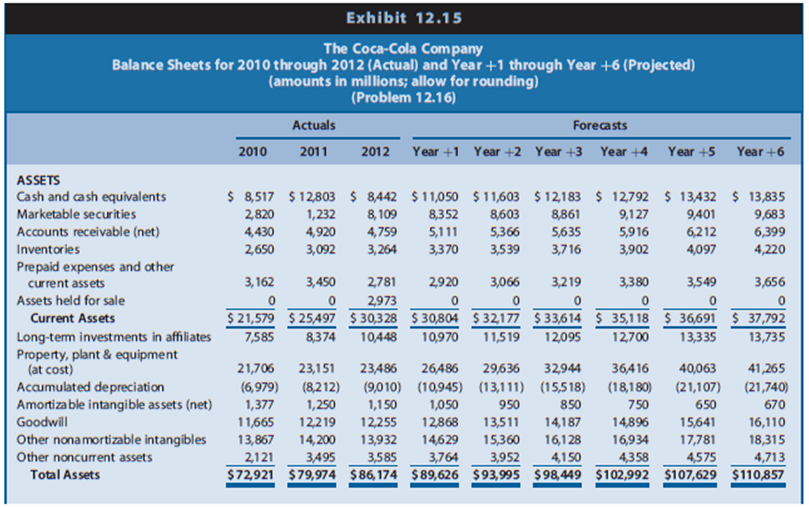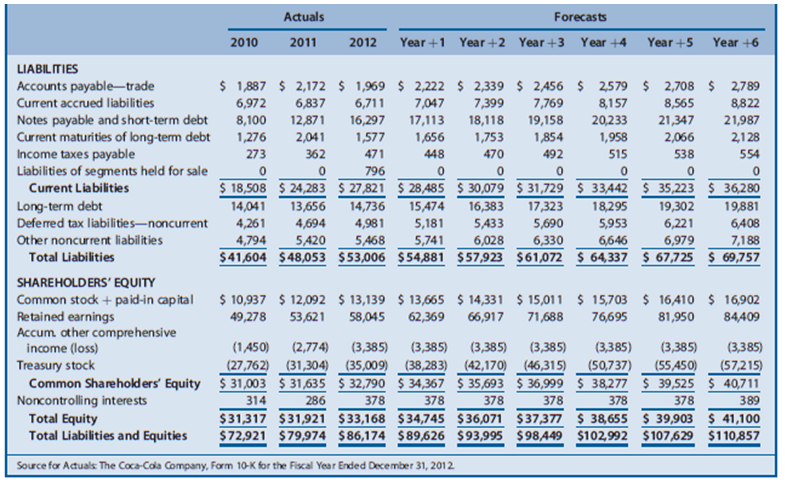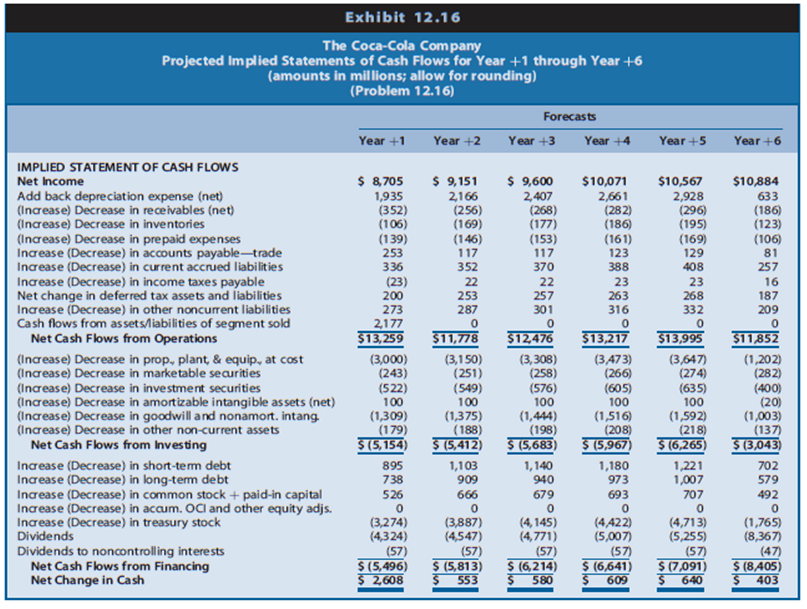The Coca-Cola Company is a global soft drink beverage company (ticker symbol KO) that is a
Question:
The Coca-Cola Company is a global soft drink beverage company (ticker symbol ¼ KO) that is a primary and direct competitor with PepsiCo. The data in Exhibits 12.14-12.16 (pages 943-946) include the actual amounts for 2010, 2011, and 2012 and projected amounts for Year þ1 to Year þ6 for the income statements, balance sheets, and statements of cash flows for Coca-Cola (in millions). The market equity beta for Coca-Cola at the end of 2012 is 0.75. Assume that the risk-free interest rate is 3.0% and the market risk premium is 6.0%. Coca-Cola has 4,469 million shares outstanding at the end of 2012, when Coca-Cola's share price was $35.48.
REQUIRED
a. Use the CAPM to compute the required rate of return on common equity capital for Coca-Cola.
b. Derive the projected free cash flows for common equity shareholders for Coca- Cola for Years +1 through +6 based on the projected financial statements. Assume that Coca-Cola's changes in cash each year are necessary for operating liquidity purposes. The financial statement forecasts for Year +6 assume that Coca-Cola will experience a steady-state long-run growth rate of 3% in Year +6 and beyond.
c. Using the required rate of return on common equity from Requirement a as a discount rate, compute the sum of the present value of free cash flows for common equity share holders for Coca-Cola for Years þ+ through +5.
d. Using the required rate of return on common equity from Requirement a as a discount rate and the long-run growth rate from Requirement b, compute the continuing value of Coca-Cola as of the start of Year +6 based on Coca-Cola's continuing free cash flows for common equity shareholders in Year +6 and beyond. After computing continuing value as of the start of Year þ6, discount it to present value at the start of Year þ1.
e. Compute the value of a share of Coca-Cola common stock.
(1) Compute the total sum of the present value of all future free cash flows for equity shareholders (from Requirements c and d).
(2) Adjust the total sum of the present value using the midyear discounting adjustment factor.
(3) Compute the per-share value estimate.
f. At the end of 2012, Coca-Cola had $32,610 million in outstanding interest bearing short-term and long-term debt on the balance sheet and no preferred stock. Assume that the balance sheet value of Coca-Cola's debt is approximately equal to the market value of the debt. The forecasts assume that Coca-Cola will face an interest rate of 3.0% on debt capital and that Coca-Cola's average tax rate will be 23% (based on the past five-year average effective tax rate). Coca-Cola also had noncontrolling interests of $378 million at that time. The forecasts assume a 15.0% cost of capital for noncontrolling interests. (For our forecasts, we assume noncontrolling interests receive dividends equal to the required rate of return each year.) Compute the weighted-average cost of capital for Coca-Cola as of the start of Year +1.




g. Beginning with projected net cash flows from operations, derive the projected free cash flows for all debt and equity stakeholders for Coca-Cola for Years +1 through
+6 based on the projected financial statements. Assume that the change in cash each year is related to operating liquidity needs.
h. Using the weighted-average cost of capital from Requirement f as a discount rate, compute the sum of the present value of free cash flows for all debt and equity stakeholders for Coca-Cola for Years +1 through +5.
i. Using the weighted-average cost of capital from Requirement f as a discount rate and the long-run growth rate from Requirement b, compute the continuing value of
Coca-Cola as of the start of Year +6 based on Coca-Cola's continuing free cash flows for all debt and equity stakeholders in Year +6 and beyond. After computing continuing value as of the start of Year þ6, discount it to present value as of the start of Year +1.
j. Compute the value of a share of Coca-Cola common stock.
(1) Compute the total value of Coca-Cola's net operating assets using the total sum of the present value of free cash flows for all debt and equity stakeholders (from
Requirements h and i).
(2) Subtract the value of outstanding debt to obtain the value of equity.
(3) Adjust the present value of equity using the midyear discounting adjustment factor.
(4) Compute the per-share value estimate of Coca-Cola's common equity shares.
Note: Do not be alarmed if your share value estimate from Requirement e is slightly different from your share value estimate from Requirement j. The weighted-average cost of capital computation in Requirement f used the weight of equity based on the market price of Coca-Cola's stock at the end of 2012. The share value estimates from Requirements e and j likely differ from the market price, so the weights used to compute the weighted-average cost of capital are not internally consistent with the estimated share values.
k. Using the free cash flows to common equity shareholders, recompute the value of Coca-Cola shares under two alternative scenarios.
Scenario 1: Assume that Coca-Cola's long-run growth will be 2%, not 3% as before, and assume that Coca-Cola's required rate of return on equity is 1% higher than the rate you computed for Requirement a.
Scenario 2: Assume that Coca-Cola's long-run growth will be 4%, not 3% as before, and assume that Coca-Cola's required rate of return on equity is 1% lower than the rate you computed in Requirement a. To quantify the sensitivity of your share value estimate for Coca-Cola to these variations in growth and discount rates, compare (in percentage terms) your value estimates under these two scenarios with your value estimate from Requirement e.
l. Using these data at the end of 2012, what reasonable range of share values would you have expected for Coca-Cola common stock? At that time, what was the market price for Coca-Cola shares relative to this range? What investment strategy (buy, hold, or sell) would you have recommended?
A person, group or organization that has interest or concern in an organization. Stakeholders can affect or be affected by the organization's actions, objectives and policies. Some examples of key stakeholders are creditors, directors, employees,... Balance Sheet
Balance sheet is a statement of the financial position of a business that list all the assets, liabilities, and owner’s equity and shareholder’s equity at a particular point of time. A balance sheet is also called as a “statement of financial... Cost Of Capital
Cost of capital refers to the opportunity cost of making a specific investment . Cost of capital (COC) is the rate of return that a firm must earn on its project investments to maintain its market value and attract funds. COC is the required rate of... Discount Rate
Depending upon the context, the discount rate has two different definitions and usages. First, the discount rate refers to the interest rate charged to the commercial banks and other financial institutions for the loans they take from the Federal...
Step by Step Answer:

Financial Reporting Financial Statement Analysis And Valuation A Strategic Perspective
ISBN: 1088
8th Edition
Authors: James M. Wahlen, Stephen P. Baginski, Mark Bradshaw





